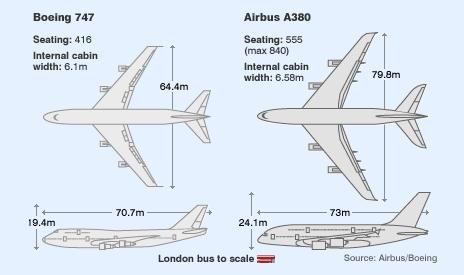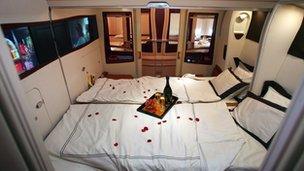Factfile: Airbus A380
- Published
The world's largest passenger aircraft, the Airbus A380, made its debut commercial flight in October 2007 with Singapore Airlines from Singapore to Sydney.
Qantas took the plane in 2008, flying the route between Melbourne and Los Angeles. Air France and Lufthansa also fly the Airbus A380, but its largest customer is Emirates, which has ordered 120 superjumbos.
However, since the start of the global recession several airlines have postponed orders, including Air France KLM Group, Qatar Airways and Virgin Atlantic Airways. A series of production problems also delayed delivery, time and again.
The A380 superjumbo project was first conceived in the early 1990s as an eventual successor to the Boeing 747, which has now been the world's mainstay long-haul aircraft for more than 30 years.
However, Boeing has hit back by stretching its 747, with its 747-8.
Development work of the A380 began in earnest in 1993.
The project, designed to challenge Boeing's hold on the long-haul flight market, is valued at about $24bn (£15bn) and each plane has an average list price of $347m (£215m).

With its twin decks of seats, the aircraft can carry 555 people in separate seat classes, or 840 passengers in an "all economy class" configuration.
The aircraft is designed to incorporate amenities such as bars, lounges, beauty salons and duty-free shops, according to operators' specifications.
But such luxury does not come cheap for the discerning flyer.
A first-class suite aboard the Singapore Airlines A380 flying London to Sydney can cost more than £35,000 for a return ticket.
A cargo version of the plane - designated the 800F - would be the world's first "triple-decker" freight aircraft, though it is not clear whether this will ever be built.
Green technologies
Although the plane can carry 35% more passengers than a Boeing 747, it consumes 12% less fuel per seat, a rate of consumption comparable with that of an economical family car, manufacturer Airbus states.
The plane's vast size also gives it a more efficient seat-distance cost than its rivals.
The A380 uses a number of pioneering technologies, including a new, lighter material Glare - GLAss-REinforced fibre metal laminate.
Used in the upper fuselage, this aluminium/glass fibre composite offers better resistance to corrosion and impacts.
The aircraft can be powered by either Rolls-Royce Trent 900 or Alliance GP7200 turbofan engines.
Delays
However, the project was plagued with delays after a star-studded launch at Airbus HQ in Toulouse in January 2005.
Delays initially centred on the 330 miles of wiring in each aircraft. It transpired that German and Spanish Airbus sites were using different software to install the wiring to their French and British counterparts.
Originally planned for 2006, the first planes suffered three major delays, with the launch customer, Singapore Airlines, finally getting hold of the first production model in October 2007.

First-class passengers on Singapore Airlines can stay in suites on board the A380
Emirates was the second airline to receive the A380 and to date is the biggest customer for the jet, with 20 planes in active service and a further 90 on order.
Qantas is also a key player for the firm, flying the A380 since 2008 with 15 planes currently in operation.
In February 2009 , the one millionth passenger flew on an A380, with Singapore Airlines.
By February 2012, A380s had flown some 17 million passengers two billion miles across the globe.
There have been a number of high-profile problems since the planes went into operation.
In November 2010, a Qantas A380 superjumbo made an emergency landing after one of the engines exploded shortly after take-off from Singapore.
A year later, a second Qantas A380 diverted to Dubai and landed safely after an oil problem forced pilots to shut down one of its four engines.
Early in 2012, the European Aviation Safety Agency ordered checks to all 68 A380s in operation following cases of cracks in wing components. The planes were not grounded and the planemaker stressed the superjumbos were safe to fly.
There are currently orders for more than 250 A380s from airlines around the world.